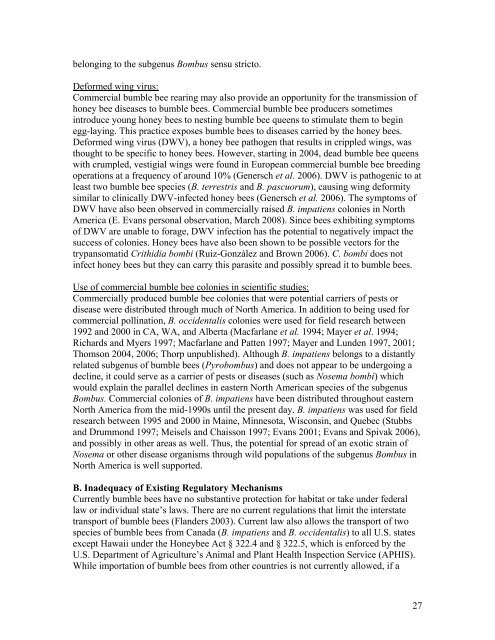Status Review of Three Formerly Common Species of Bumble Bee ...
Status Review of Three Formerly Common Species of Bumble Bee ...
Status Review of Three Formerly Common Species of Bumble Bee ...
You also want an ePaper? Increase the reach of your titles
YUMPU automatically turns print PDFs into web optimized ePapers that Google loves.
elonging to the subgenus Bombus sensu stricto.Deformed wing virus:Commercial bumble bee rearing may also provide an opportunity for the transmission <strong>of</strong>honey bee diseases to bumble bees. Commercial bumble bee producers sometimesintroduce young honey bees to nesting bumble bee queens to stimulate them to beginegg-laying. This practice exposes bumble bees to diseases carried by the honey bees.Deformed wing virus (DWV), a honey bee pathogen that results in crippled wings, wasthought to be specific to honey bees. However, starting in 2004, dead bumble bee queenswith crumpled, vestigial wings were found in European commercial bumble bee breedingoperations at a frequency <strong>of</strong> around 10% (Genersch et al. 2006). DWV is pathogenic to atleast two bumble bee species (B. terrestris and B. pascuorum), causing wing deformitysimilar to clinically DWV-infected honey bees (Genersch et al. 2006). The symptoms <strong>of</strong>DWV have also been observed in commercially raised B. impatiens colonies in NorthAmerica (E. Evans personal observation, March 2008). Since bees exhibiting symptoms<strong>of</strong> DWV are unable to forage, DWV infection has the potential to negatively impact thesuccess <strong>of</strong> colonies. Honey bees have also been shown to be possible vectors for thetrypansomatid Crithidia bombi (Ruiz-González and Brown 2006). C. bombi does notinfect honey bees but they can carry this parasite and possibly spread it to bumble bees.Use <strong>of</strong> commercial bumble bee colonies in scientific studies:Commercially produced bumble bee colonies that were potential carriers <strong>of</strong> pests ordisease were distributed through much <strong>of</strong> North America. In addition to being used forcommercial pollination, B. occidentalis colonies were used for field research between1992 and 2000 in CA, WA, and Alberta (Macfarlane et al. 1994; Mayer et al. 1994;Richards and Myers 1997; Macfarlane and Patten 1997; Mayer and Lunden 1997, 2001;Thomson 2004, 2006; Thorp unpublished). Although B. impatiens belongs to a distantlyrelated subgenus <strong>of</strong> bumble bees (Pyrobombus) and does not appear to be undergoing adecline, it could serve as a carrier <strong>of</strong> pests or diseases (such as Nosema bombi) whichwould explain the parallel declines in eastern North American species <strong>of</strong> the subgenusBombus. Commercial colonies <strong>of</strong> B. impatiens have been distributed throughout easternNorth America from the mid-1990s until the present day. B. impatiens was used for fieldresearch between 1995 and 2000 in Maine, Minnesota, Wisconsin, and Quebec (Stubbsand Drummond 1997; Meisels and Chaisson 1997; Evans 2001; Evans and Spivak 2006),and possibly in other areas as well. Thus, the potential for spread <strong>of</strong> an exotic strain <strong>of</strong>Nosema or other disease organisms through wild populations <strong>of</strong> the subgenus Bombus inNorth America is well supported.B. Inadequacy <strong>of</strong> Existing Regulatory MechanismsCurrently bumble bees have no substantive protection for habitat or take under federallaw or individual state’s laws. There are no current regulations that limit the interstatetransport <strong>of</strong> bumble bees (Flanders 2003). Current law also allows the transport <strong>of</strong> twospecies <strong>of</strong> bumble bees from Canada (B. impatiens and B. occidentalis) to all U.S. statesexcept Hawaii under the Honeybee Act § 322.4 and § 322.5, which is enforced by theU.S. Department <strong>of</strong> Agriculture’s Animal and Plant Health Inspection Service (APHIS).While importation <strong>of</strong> bumble bees from other countries is not currently allowed, if a27
















